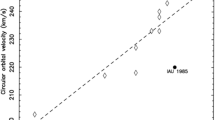Abstract
Most of the day-to-day fluctuation (originally believed to be error) in the Princeton solar oblateness observations is well described as the signal due to a ∼10 km distortion of the solar photosphere rotating rigidly with a period of 12.22±0.12 days (sidereal). This ‘solar-rotator’ signal is well-defined by the observations and seems clearly significant statistically. Owing to the apparent precession of the solar spin-axis on the sky, the signal is not strictly periodic and has a wave-form that evolves with time in a predictable way. The previously discussed enigmatic periodicity of the oblateness residuals, for which no non-solar sources were found, is eliminated when the solar-rotator signal is subtracted. The residual errors are then found to be normally distributed and uncorrelated. Including the solar-rotator signal in the least-square fit increases the implied static oblateness by 16% to Δr = 45.8±3.3 millisec (equatorial excess radius). Both the static oblateness signal and the solar-rotator signal might be interpreted phenomenonologically as ‘brightness’ signals due to a rigidly rotating non-uniform distribution of temperature in the upper photosphere. However, such a description encounters physical difficulties when the requirements of energy and momentum balance are considered. Including the excess static oblateness yields a distortion in the form of an ellipoid whose major axis is tilted 85° from the solar axis. Possible conflicts with other recent observations are discussed.
Similar content being viewed by others
References
Brandt, Siegmund; 1970, Statistical and Computational Methods in Data Analysis: (Amsterdam: North Holland Pub.).
Dicke, R. H.: 1970, Astrophys. J. 159, 1.
Dicke, R. H.: 1972, Astrophys. J. 176, 479.
Dicke, R. H.: 1973, Astrophys. J. 180, 293.
Dicke, R. H.: 1974, Solar Phys. 37, 271.
Dicke, R. H.: 1974a, Astrophys. J. 190, 187.
Dicke, R. H.: 1974b, Astrophys. J. 190, 187 (see for references to other papers on facular signals).
Dicke, R. H. and Goldenberg, H. Mark: 1974, Astrophys. J. Suppl. 27, No. 241, 131–182.
Durney, B.: 1973, Astrophys. J. 183, 665.
Hill, H. A. and Stebbins, R. T.: 1975, Astrophys. J. 200, 471.
Ingersoll, A. P. and Spiegel, E. A.: 1971, Astrophys. J. 163, 375.
Moore, R. L.: 1975, (private communication, California Institute of Technology).
Wilks, S.: 1938, Ann. Math. Stat. 9, 60.
Author information
Authors and Affiliations
Additional information
This research was supported by the Sherman Fairchild Distinguished Scholar program at the California Institute of Technology and by the National Science Foundation at both universities under contracts No. MPS 75-01398 at Cal Tech and No. MPS 71-03266 at Princeton University.
Sherman Fairchild Distinguished Scholar (1975).
Rights and permissions
About this article
Cite this article
Dicke, R.H. Evidence for a solar distortion rotating with a period of 12.2 days. Sol Phys 47, 475–515 (1976). https://doi.org/10.1007/BF00154759
Received:
Revised:
Issue Date:
DOI: https://doi.org/10.1007/BF00154759




